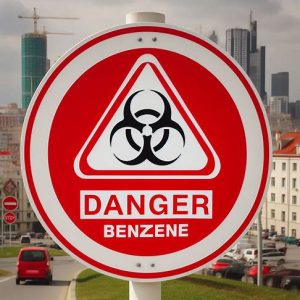In this article, I’ll address the dangers of Benzene, a popular chemical used in many industries.

Benzene Toxic Pit lead to deadly cancer in a California man
California Benzene Toxic Pit Lawsuit
A California jury in a trial in Santa Barbara awarded $63 million in damages against Chevron. The jury found the oil giant was liable for covering up a toxic chemical pit on land purchased by a man who built a house on it and was later diagnosed with a deadly blood cancer.
According to Kevin Wright’s lawsuit, he developed multiple myeloma after building his home directly over the chemical pit near Santa Barbara in 1985. Wright lived in that house for about two years but 27 years later, he was diagnosed with a type of blood cancer that can be caused by benzene exposure.
In 2015, Wright was diagnosed with multiple myeloma, has received two stem cell treatments, and is getting chemo once a month, and he’s going to continue to do that for the foreseeable future.
Kevin Wright alleged that starting in 1974, Chevron subsidiary Union Oil Company of California had operated a sump pit for oil and gas production, a process that left the dangerous carcinogenic chemical benzene on the property. Union Oil hid the use of a toxic chemical sump pit for production purposes in 1974, land that was eventually sold in 1983.
Wright bought the land and built the house in 1985. Nearly three decades later, he was diagnosed with the cancer that attacks plasma cells in the blood. Benzene, a known carcinogen, was discovered at toxic levels in the soil beneath his home in Santa Maria decades after the property was sold again.
Benzene Toxic Pit Punitive Damages
The jurors in Santa Barbara returned the $63 million verdict, awarding compensatory and punitive damages. “Chevron poisoned the ground, they poisoned this community, and they tried to poison the science to cover it all up,” said Jakob Norman, an attorney for Wright. “This case is a blatant example of environmental pollution and corporate malfeasance that directly caused immense physical harm to our client.”
The jury found Unocal (a k a Union Oil) and its parent company, Chevron grossly negligent for waiting 41 years to clean up a benzene-contaminated underground waste sump in what’s now a Santa Maria residential neighborhood.
Kevin Wright, who developed terminal blood cancer years after building his dream house directly above the sump site in 1985, was awarded $22 million for actual damages.
Wright is alive today, thanks only to relentless chemotherapy treatments that leave him so weakened he has to crawl up his stairs.
The jury also awarded Wright an additional $41 million for punitive damages. That translates to $1 million for each year Union Oil failed to abide by a California state law then in effect that required oil companies to excavate and remove the toxic remains, drilling muds, cuttings, contaminated water, and other industrial byproducts of oil drilling, before covering the site with fresh soil and selling the land for real estate development.
“They cut corners, and my life was turned upside down as a result,” Wright said in a statement. “Chevron’s continued denial of the harm they caused is a shameful reminder that this company values only profits, not people.”
Despite strict California laws related to the disposal of these toxic chemicals in the ground, Chevron denied any wrongdoing and supplied bogus research from the American Petroleum Institute that argued Benzene was less harmful.
Chevron Unocal was Grossly Negligent in the Benzene Toxic Pit Lawsuit
Union Oil and a partnership of five other oil companies created a mega Santa Maria oil patch in 1964, called the Santa Maria Valley Oil & Gas Field, on land that today is completely residential. For 10 years, this group of oil companies drilled and produced. Then they covered the land with soil.
Unocal should have hauled off the contaminated soil from the sump, which would become Wright’s home, it would have taken them a few hours in remediation efforts. When Chevron assumed control of the land in 2011, having purchased Union Oil in 2005, Chevron initiated the cleanup and remediation work. By 2016, 6,650 tons of oil-contaminated soil would be taken away, but this was too little too late.
 Dallas Fort Worth Injury Lawyer Blog
Dallas Fort Worth Injury Lawyer Blog

